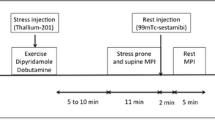Abstract
Background: Simultaneous dobutamine stress echocardiography (DSE) and99mTc-MIBI-SPET (DMS) for the evaluation of the presence and the extent of coronary artery disease (CAD) were assessed for a head to head comparison regarding the diagnostic accuracy of the two tests.
Methods and Results: Forty-five consecutive patients (33 males and 12 females: 53±6.8 yr.) underwent exercise electrocardiography and simultaneous dobutamine stress echocardiography and MIBI-SPET imaging. Coronary angiography was performed in all patients (significant coronary stenosis > 50%). On the basis of the results of exercise electrocardiogram the pre-test probability for coronary artery disease (Diamond's algorithm) was low (45.6±12.7 %). The overall specificity, sensitivity and predictive accuracy of Echo-dobutamine stress test for diagnosis of the presence or absence of CAD were: specificity 82%, sensitivity 76%, diagnostic accuracy 80%, positive predictive value 90%, negative predictive value 40%. The overall specificity, sensitivity and predictive accuracy of MIBI-SPET-dobutamine test for diagnosis of the presence or absence of CAD were: specificity 86%, sensitivity 87%, diagnostic accuracy 84%, positive predictive value 97%, negative predictive value 54%. MIBI-SPET-dobutamine test showed a significantly higher sensitivity in comparison with ECHO-dobutamine test (P<0.05).
Conclusion: Both noninvasive methods for the detection of CAD showed a good diagnostic accuracy. Nevertheless the SPET model showed an higher sensitivity in comparison with DSE model, essentially in the presence of a lower extent of CAD and during submaximal test.
Similar content being viewed by others
References
Picano E. Stress echocardiography. From pathophysiological toy to diagnostic tool. Circulation 1992; 85: 1604–12.
Salustri A, Fioretti PM, Pozzoli MMA, McNeil AJ, Roelandt JRTC. Dobutamine stress echocardiography: its role in the diagnosis of coronary artery disease. Eur Heart J: 1992; 13: 70–7.
Mason JR, Palc RT, Freeman ML, Virupannavar S, Loeb HS, Kaplan E, Gunnar RM; Thallium scintigraphy during dobutamine infusion: non exercise-dependent screening test for coronary disease. Am Heart J 1984; 107: 481–85.
Pennell DJ, Underwood DSR, Swanton RH, Walker JM, Ell PJ. Dobutamine thallium myocardial perfusion tomography. J Am Coll Cardiol 1991; 18: 1471–9.
McGillem MJ, DeBoe SF, Friedman HZ, Mancini GBJ. The effect of dopamine and dobutamine on regional function in presence of rigid coronary stenoses and subcritical impairments of reactive hyperaemia. Am Heart J 1988; 115: 970–7.
Tuttle RR, Pollock GD, Todd G, MacDonald B, Tust R, Dusenberry W: The effect of dobutamine on cardiac oxygen balance, regional blood flow and infarction severity after coronary artery narrowing in dogs. Circ Res 1977; 41: 357–64.
Wasserman K, Hansen JE, Sue DY, Whipp BJ. Principles of exercise testing and interpretations. Philadelphia. Lea & Febiger, 1987.
Fung AY, Gallegher KP, Buda AJ. The physiologic basis of dobutamine as compared with dipyridamole stress intervention in the assessment of critical coronary stenoses. Circulation 1987; 76: 943–51.
Diamond GA, Forrester JS. Analysis of probability as an aid in the clinical diagnosis of coronary artery disease. N Engl J Med 1979; 300: 1350–8.
Segar DS, Brown SE, Sawada SG, Ryan T, Feigenbaum H. Dobutamine stress echocardiography: correlation with coronary lesion severity as determined by quantitative angiography. J Am Coll Cardiol 1992; 19: 197–202.
Schiller NB, Shan PM, Crawford M, et al. American Society of Echocardiography Committee on standards subcommittee on quantitation of two dimensional echocardiograms: Recommendations for quantitation of the left ventricle by two dimensional echocardiography. J Am Soc Echo 1989; 2: 358–67.
Berman DS, Kiat H, Train KV, Garcia E, Friedman J, Maddahi J. Technetium 99m Sestamibi in the assessment of chronic artery disease. Semin Nucl Med 1991; 21: 190–212.
Judkins MP Selective coronary arteriography, a percutaneous transfemoral technic. Radiology 1967; 89: 815–23.
Mertens H, Sawada SG, Ryan T at al. Symptoms, adverse effects and complications associated with dobutamine stress echocardiography. Circulation 1993; 88: 15–9.
Sawada SG, Segar DS, Ryan T et al. Echocardiographic detection of coronary artery disease during dobutamine infusion. Circulation 1991; 83: 1605–14.
Cohen JL, Greene TO, Ottenweller J, Binenbaum SZ, Wilchfort SD, Kim CS. Dobutamine digital echocardiography for detecting coronary artery disease. Am J Cardiol 1991; 67: 1311–8.
Mazeika PK, Nazadin A, Oakley CM. Dobutamine stress echocardiography for detection and assessment of coronary artery disease. J Am Coll Cardiol 1992; 19: 1203–11.
Marwick T, D'Hondt AM, Baudhuin T, et al. Optimal use of dobutamine stress for the detection and evaluation of coronary artery disease: combination with echocardiography or scintigraphy or both? J Am Coll Cardiol 1993; 22: 159–67.
Marwick T, Willemart B, D'Hondt AM et al. Selection of the optimal non exercise stress test for the evaluation of ischemic regional myocardial dysfunction and malperfusion: comparison of dobutamine and adenosine using echocardiography and Tc 99mMIBI single photon emission computed tomography. Circulation 1993; 87: 345–54.
Mairesse GH, Marwick TH, Vanoverschelde JJ, Baudhuin T, Wijns W, Melin JA, Detry JR. How accurate is dobutamine stress electrocardiography for detection of coronary artery disease. Comparison with two-dimensional echocardiography and technetium - 99m MIBI perfusion scintigraphy. J Am Coll Cardiol 1994; 24: 920–7.
Salustri A, Fioretti PM, Pozzoli MMA, McNeill AJ, Roelandt JRTC. Dobutamine stress echocardiography: its role in the diagnosis of coronary artery disease. EHJ 1992; 13, 70–77.
Pozzoli MMA, Fioretti PM, Salustri A, Reijs AEM, Roelandt JRTC. Exercise echocardiography and technetium-99m-MIBI SPECT in the detection of coronary artery disease. AM J Cardiol 1991; 67: 350–55.
Di Bello V, Bellina CR, Gori E, Molea N, Talarico L, Boni G, Magagnini E, Matteucci F, Giorgi D, Lazzeri E, Bertini A, Romano MF, Bianchi R, Giusti C. Incremental diagnostic value of Dobutamine stress echocardiography and dobutamine scintigraphy (99mTc- MIBI-SPET) for assessment of presence and extent of coronary artery disease. Journal of Nuclear Cardiology; in press.
Author information
Authors and Affiliations
Rights and permissions
About this article
Cite this article
Di Bello, V., Riccardo Bellina, C., Molea, N. et al. Simultaneous dobutamine stress echocardiography and dobutamine scintigraphy (99mTc-MIBI-SPET) for assessment of coronary artery disease. Int J Cardiac Imag 12, 185–190 (1996). https://doi.org/10.1007/BF01806221
Accepted:
Issue Date:
DOI: https://doi.org/10.1007/BF01806221




